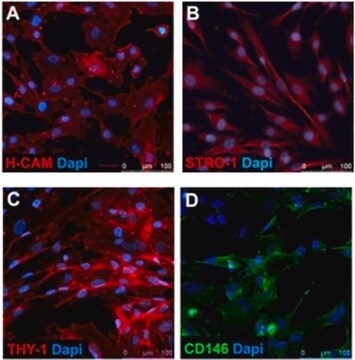C-12974
Human Mesenchymal Stem Cells (hMSC)
Derived from bone marrow, 500,000 cryopreserved cells
Synonym(s):
Mesenchymal Stem Cell Culture
About This Item
Recommended Products
biological source
human bone marrow
packaging
pkg of 500,000 cells
morphology
(stromal)
technique(s)
cell culture | mammalian: suitable
shipped in
dry ice
storage temp.
−196°C
General description
Cell Line Origin
Application
Quality
Warning
Subculture Routine
Other Notes
Recommended products
Disclaimer
Storage Class
12 - Non Combustible Liquids
wgk_germany
WGK 1
flash_point_f
Not applicable
flash_point_c
Not applicable
Choose from one of the most recent versions:
Certificates of Analysis (COA)
It looks like we've run into a problem, but you can still download Certificates of Analysis from our Documents section.
If you need assistance, please contact Customer Support.
Already Own This Product?
Find documentation for the products that you have recently purchased in the Document Library.
Customers Also Viewed
Articles
Are your mesenchymal stem cells really MSCs? Learn more about the MSC characterization guidelines proposed by the International Society for Cellular Therapy (ISCT).
Protocol to differentiate human mesenchymal stem cells into neurons with extensive dendrites and axons in 3 days. Explore over 350 PromoCell products on Sigma.com.
Highly characterized human mesenchymal stem cell lines from bone-marrow, adipose and umbilical cord along with serum-free MSC expansion and differentiation media.
Overview of primary cells and media usage in biomedical culture applications highlights differences from cell lines.
Protocols
Information about mesenchyme, specifically mesenchymal stem cell procotols. Step-by-step cell culture protocols for mesenchymal stem cell (MSC) isolation, expansion and differentiation.
Related Content
Explore expert protocols and culture media for human primary cell lines to replicate biological systems accurately.
Our team of scientists has experience in all areas of research including Life Science, Material Science, Chemical Synthesis, Chromatography, Analytical and many others.
Contact Technical Service








